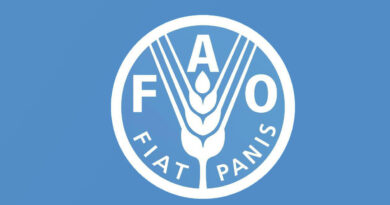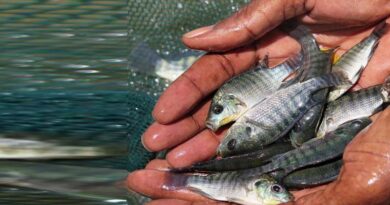FAO leads global efforts to strengthen aquaculture for food and sustainable development
18 May 2023, Rome: Aquaculture has seen enormous progress in recent decades and is destined to produce the majority of the ever-growing demand for aquatic food.
The sector now needs an updated set of governing principles that ensure that it expands and intensifies, embracing modern technologies, in a way that is environmentally and socially responsible, economically viable, and able to meet the needs of present and future generations. This need is outlined in a set of articles published this week by leading experts in the field, arising from the latest Global Conference on Aquaculture Millennium +20 held in Shanghai, organized by the Food and Agriculture Organization of the United Nations (FAO) and partners as part of a decadal series of such conferences.
“Given that aquaculture now supplies around 50 percent of aquatic food, and given its potential to contribute to so many of the UN’s Sustainable Development Goals, we all need to focus on how to move it forward in a sustainable way,” said Xinhua Yuan, FAO’s Deputy Director for Aquaculture. “Fish and other aquatic products can and will play a major role in meeting the dietary demands of all people, helping improve the resilience of global food system, while also meeting the food security needs of the poorest,” he added.
The publication of the eight thematic review articles as a special issue of the Journal of the World Aquaculture Society coincides with the holding of 12th session of the Sub-Committee on Aquaculture of FAO’s Committee on Fisheries, the inter-governmental forum that guides the FAO in formulating aquaculture and fisheries policy advice. One of the major items on the agenda for the Sub-Committee, taking place 16-19 May in Hermosillo, Mexico, is the consideration of new Draft Voluntary Guidelines for Sustainable Aquaculture (GSA), and the publication of these thematic reviews provides useful context for these discussions and more broadly to FAO’s vision for a Blue Transformation.
The objective is to achieve the further intensification and expansion of aquaculture sustainably, in a way that satisfies global demand for aquatic food and distributes benefits equitably, with care regarding social responsibility, pollution and other considerations, he added. Innovative technologies that can increase productivity and reduce waste, as well as enhance inclusion of small-scale operators in the sector, are widely available but need to be applied, particularly outside of Asia, and targeted in areas where aquaculture production has the greatest potential for growth. Moreover, aquaculture practices on average produce fewer greenhouse gas emissions than other forms of animal production.
The eight articles discuss critical themes for aquaculture, including production methods, social issues and planetary health, nutrition, genetic resources, biosecurity, governance, and inclusive market access.
Some key messages
The future growth of aquaculture should be climate smart even as we seek to use the ocean more effectively, efficiently and intelligently to supply food. Emphasising integrated growth in low trophic level culture species (such as seaweeds and filter feeding bivalve molluscs and finfish) will be important in this regard.
Aquaculture is mostly practiced in Asia and needs to be distributed more evenly, with immediate efforts to stimulate its development in Africa, Latin America and Small Island Developing States.
Great progress has been achieved in improving feed efficiency and reducing the use of marine sourced ingredients but more innovation will be needed, especially for many of the species being farmed in the developing world.
In contrast to terrestrial agriculture, selective breeding programmes to develop more efficient farmed types of aquatic species are heavily underutilized, currently accounting for only around 15 percent of production.
Biosecurity should be enhanced and take a more proactive approach through improved disease-alerting systems, integrated data and regulatory frameworks that reduce the risk of the spread of aquatic epidemic diseases.
Digital and electronic technologies can be harnessed to improve food safety concerns and certification protocols, such as traceability system, e-commerce, as well as broadening market access.
There is a need for many countries to develop and implement supportive, dedicated legislation, through a lead agency, to coordinate regulations that promote sustainable development whilst ensuring public wellbeing without overly constraining the capacity of aquaculture systems to cope with environmental and social challenges.
Having established itself as a major food producing and economic sector, aquaculture now needs to proactively integrate social responsibility and human wellbeing perspectives at all scales, including both workers and communities at large.
Certification of sustainability and of decent work standards is a downstream demand, and yet the burdens of compliance fall disproportionately on producers, especially smaller-scale aquaculture operators. Mechanisms to redistribute costs and benefits equitably between producers and retailer should be sought and implemented.
A few facts
Some 126 million tonnes of live weight aquaculture production, including aquatic animals and algae, was produced in 2021, about half of it consisting of farmed finfish.
The estimated farmgate value of the output was $296.5 billion.
Asia accounts for more than 90 percent of global aquatic animal production. The Americas, Europe and Africa combined account for 8.2 percent.
Around 700 species are currently being cultured around the world, but about half of global production is made from just 12 species.
Also Read: Decrease in area under Summer Crops in the country; Paddy down by 6 percent
(For Latest Agriculture News & Updates, follow Krishak Jagat on Google News)















